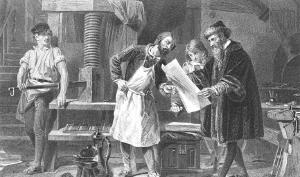Issue Date: September 19, 2003
Since Gutenberg the church has grown up with print media, has used its power for good and is comfortable with written words, books and libraries. It has been a formidable force in print history. The early days of radio were good ones for the church as, essentially, it was an educational tool. The church had something to say and we, often, had charismatic individuals who could say it well over the wireless. Vatican Radio and its international affiliates, particularly in the Third World, remain a vital contributor to the educational life of many countries. By the late 1940s in the First World, however, the nature of radio was changing from education to entertainment. Various dioceses that owned radio stations struggled to stay up with this change and so went on to sell their interests in them. It took the church some time to take moving pictures seriously. By 1910 we began to realize the evangelical possibilities of this medium, but wanted a proprietary authority over biblical stories and especially the image of Jesus. When we didn’t get it, we weighed in with the Hays Code in Hollywood and Legion of Decency film ratings. With the notable exception of Paulist Pictures (producer of “Romero”), and except in a continuing role as critic and censor, the church has sat watching and whining on the sidelines of Hollywood. When in 1913 the world’s first Film Censorship Board was established in Britain, it gave way to intense pressure from the churches to issue two immediate prohibitions against “nudity” and “any depiction of Christ.” As late as 1935 the epic film “Barabbas” had Jesus speaking in many scenes, but he is never pictured. It was not until the early 1960s that a full-frontal Jesus again appeared on the large screen. When television arrived, there was a happy coalescence between the churches that knew that this medium was a valuable opportunity for religious education and evangelization, and television networks who needed to fill their on-air hours. Masterfully, Archbishop Fulton Sheen led the Catholic charge. Today, Loyola Productions, Family Theater and Paulist Pictures are about the only middle-of-the- road church outlets left producing media materials for national networks. In the church’s absence, the largely unrepresentative EWTN has filled the gap. Once, all major Catholic dioceses had Catholic communications offices that looked after local television and radio programming, and in some cases had care for the diocesan newspaper and public relations. Interview-format television and talk-back radio were the styles that best suited the church’s objectives. Some of these programs, especially on radio, were very successful. Where the programs did not rate well, diocesan officials could not justify the program’s budget. As networks demanded higher production values, the pressure came for Catholic communications offices to produce high-quality programs on a very slight budget. Given that Catholic identity was not explicit in some of these programs, some diocesan officials felt that it wasn’t worth the effort and money. Today if a diocesan Catholic communications office exists at all, it is primarily concerned with public relations and may also edit the diocesan newspaper. The Internet is offering new opportunities for the church to be a more effective presence in the media world. Largely text-based and informational and educational in its thrust, the church understands this medium, can see its potential and can afford its costs. Data casting may offer similar opportunities in the future. -- Richard Leonard National Catholic Reporter, September 19, 2003 |
